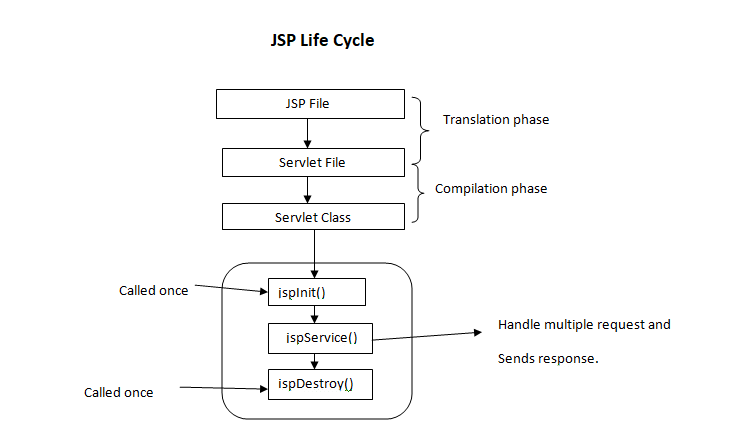Java - JSP
JSP組成元素
HTML樣板文字
同HTML語法
Script Elements
註解(comment):
<%-- This is a JSP comment --%>
<%--
This is a JSP comment can span
in multiple lines
--%>
運算式(expression):
// The syntax of an expression is as follows:
<?= expression ?>
// For example, if you want to display the current date and time,
// you can use an expression as follows:
<%= new java.util.Date()%>
程序片段(scriptlet):
// The following illustrates the syntax of scriptlet:
<% // any java source code here %>
// In this example, we display a greeting message based on the current time of the day
// using the scriptlet.
<%@page contentType="text/html" pageEncoding="UTF-8"%>
<!DOCTYPE HTML PUBLIC "-//W3C//DTD HTML 4.01 Transitional//EN"
"http://www.w3.org/TR/html4/loose.dtd">
<html>
<head>
<title>JSP syntax</title>
</head>
<body>
<%
// using scriptlet
java.util.Calendar now = new java.util.GregorianCalendar();
String tod = "";
if (now.get(now.HOUR_OF_DAY) < 12) {
tod = "Morning!";
} else if (now.get(now.HOUR_OF_DAY) < 18) {
tod = "Afternoon!";
} else {
tod = "Evening!";
}
%>
Good <%=tod%>
</body>
</html>
宣告(declaration):
//For example, if you want to declare a variable x,
// you can use JSP declaration as follows:
<%! int x = 10; %>
// The final semicolon(;) is required.
The difference between a variable using declaration and a variable is declared using scriptlet is that a variable declared using declaration tag is accessible by all methods, while a variable declared using scriptlet is only accessible to the
_jspservice()method of the generated servlet from the JSP page.
指令(directive):
<%@ page contentType="text/html"%>
page:定義頁面的屬性language:預設為Javaimport:import="java.sql.Date, java.util.*, java.io.*"(不要加分號semicolon)session:預設為true。只有當此屬性為true時,隱含變數session才會出現errorPage:指定處理發生錯誤的網頁isErrorPage:是否為處理錯誤的網頁。參考上面的說明,預設為falsecontentType:此網頁輸出資料的MIME形態與回應文字資料的編碼pageEncoding:此網頁所用的編碼。省略時依據contentType屬性isElIgnored:是否忽略EL,即視EL為字串,不做運算。預設為falsebuffer:指定輸出緩衝區的大小。預設為8kb
taglib:標籤庫指令描述了要使用的JSP標籤庫(JSTL)include:告知JSP編譯器把另外一個文件內容完全包含至當前JSP文件中- 靜態包含(效能高):
<%@ include file="/public/header.html" %> - 動態包含(可以傳參數):
<jsp:include page="/public/herder.html" /> - 動態包含(可以傳參數):
<c:import url="/public/herder.html"">
- 靜態包含(效能高):
Expression Language
(empty)
Standard Actions
(empty)
JSP Standard Tag Library
作用:
EL表达式可以简化JSP页面,减少大量Java代码。但是,对于一些场景,你会发现依然必须在JSP中嵌入Java代码才可以使得页面呈现出想要的结果,比如:
- 依据某个条件决定显示的HTML内容——导航栏根据用户是否登录的状态显示不同的内容
- 循环显示一段HTML内容,比如博客列表中每一个条目的文章
因为HTML本身并没有
<if>,<for>这样的标签来完成动态生成网页的任务。 所幸的是,Java EE提供了这样的扩展标签库——JSTL,它不仅能提供条件判断、循环等常用实现程序逻辑的标签,还提供很多扩充标签让开发者能够更加方便的实现业务功能。JSTL与EL表达式相互配合使用,就能将基本在JSP中消除Java代码了。
set
<c:set var="salary" scope="session" value="${2000*2}"/>
<c:out value="${salary}"/>
out
<c:out value="{blog.url}" escapeXml="true" default="/blog" />
forEach
<c:forEach var="i" begin="1" end="5">
Item <c:out value="${i}"/><p>
</c:forEach>
<c:forEach var="blog" items="${blogs}">
<c:out value="${blog.title}"/><p>
</c:forEach>
if
<c:set var="salary" value="${2000*2}"/>
<c:if test="${salary > 2000}">
<p>My salary is: <c:out value="${salary}"/><p>
</c:if>
choose
<c:set var="salary" scope="session" value="${2000*2}"/>
<p>Your salary is : <c:out value="${salary}"/></p>
<c:choose>
<c:when test="${salary <= 0}">
Salary is very low to survive.
</c:when>
<c:when test="${salary > 1000}">
Salary is very good.
</c:when>
<c:otherwise>
No comment sir...
</c:otherwise>
</c:choose>
JSP處理機制
作用域對象
Page > Request > Session > Application的查找,其實相當於依次調用:
pageContext.getAttribute("blog")request.getAttribute("blog")session.getAttribute("blog")application.getAttribute("blog")
一個變量能找到,是因為之前調用了對應的setAttribute()方法進行了設置
簡單來理解一下這四個作用域,一個變量所在的作用域越在後面,存活的時間就越長
pageContext對應於一個頁面request對應於一個請求,一個請求是可以包含幾個頁面的(比如使用了include和forward等操作)session對應於一個會話(一般是一個用戶產生一個會話),在會話中會產生多個請求application對應於整個Web應用,一個Web應用匯產生很多會話,所以application中的屬性會在整個應用的生命週期存在
JSP內置對象
EL隱式對象
JSP生命週期
A Java Server Page life cycle is defined as the process started with its creation which later translated to a servlet and after ward servlet lifecycle comes into play. This is how the process goes on until its destruction.

- Translation of JSP page to Servlet
- Compilation of JSP page (Compilation of JSP into test.java)
- Classloading (test.java to test.class)
- Instantiation (Object of the generated Servlet is created)
- Initialization (
jspInit()method is invoked by the container) - Request processing (
_jspService()is invoked by the container) - JSP Cleanup (
jspDestroy()method is invoked by the container)
We can override jspInit(), jspDestroy() but we cannot override _jspService() method